 I arrived at the Guangzhou East Train Station at 11 a.m. I was met at the station by Jiajin, our liaison officer during the program who was nice enough to take me around Guangzhou during my last day in China. We hadn't been able to see Guangzhou during the program in Guangdong Province since the activities were in Dongguan City.From the Guangzhou East Station, we took a subway to the Guangzhou Train Station (there are two stations in Guangzhou) since the hotel I was going to stay in was right beside it. It was convenient for me since right beside the hotel was the China Southern office and the pick-up point for the airport shuttle which left every 15 minutes. I paid RMB150 for a single room.We had lunch at the KFC beside the hotel. From there, we took a subway to the Sun Yat-Sen Memorial Hall. The hall is situated on the southern slope of Yuexiu Hill and was constructed between 1929 and 1931 by the people of Guangzhou and overseas Chinese as a monument to Dr. Sun Yat-sen, the forerunner of Chinese democratic revolution.
I arrived at the Guangzhou East Train Station at 11 a.m. I was met at the station by Jiajin, our liaison officer during the program who was nice enough to take me around Guangzhou during my last day in China. We hadn't been able to see Guangzhou during the program in Guangdong Province since the activities were in Dongguan City.From the Guangzhou East Station, we took a subway to the Guangzhou Train Station (there are two stations in Guangzhou) since the hotel I was going to stay in was right beside it. It was convenient for me since right beside the hotel was the China Southern office and the pick-up point for the airport shuttle which left every 15 minutes. I paid RMB150 for a single room.We had lunch at the KFC beside the hotel. From there, we took a subway to the Sun Yat-Sen Memorial Hall. The hall is situated on the southern slope of Yuexiu Hill and was constructed between 1929 and 1931 by the people of Guangzhou and overseas Chinese as a monument to Dr. Sun Yat-sen, the forerunner of Chinese democratic revolution. Since Jiajin had classes at 3 p.m., we took a 40-minute bus to the Guandong University of Foreign Studies where he is a graduating student. I stayed at his dorm and surfed the Internet while he was in class.After his class, we took another bus back to the city center. I wanted to pass by a supermarket to check out the local food. We decided to buy dinner there. Got myself some rice noodles and vegetable pie while he got some dumplings. Also bought some dried fruits and my supply of water. From there, we walked towards the Shangxiajiu Walking Street (上下九商业步行街) a famous shopping area of Guangzhou.What I liked about the place was the glass covered display of an old street which was accidentaly discovered in 2002 during excavations for a redevelopment project. But instead of destroying the old street and other remnants of the city's heritage, like what Mayor Atienza did in Mehan Gardens and Cuartel Meisic, Guangzhou covered it with glass and it is now an attraction of the walking street.
Since Jiajin had classes at 3 p.m., we took a 40-minute bus to the Guandong University of Foreign Studies where he is a graduating student. I stayed at his dorm and surfed the Internet while he was in class.After his class, we took another bus back to the city center. I wanted to pass by a supermarket to check out the local food. We decided to buy dinner there. Got myself some rice noodles and vegetable pie while he got some dumplings. Also bought some dried fruits and my supply of water. From there, we walked towards the Shangxiajiu Walking Street (上下九商业步行街) a famous shopping area of Guangzhou.What I liked about the place was the glass covered display of an old street which was accidentaly discovered in 2002 during excavations for a redevelopment project. But instead of destroying the old street and other remnants of the city's heritage, like what Mayor Atienza did in Mehan Gardens and Cuartel Meisic, Guangzhou covered it with glass and it is now an attraction of the walking street.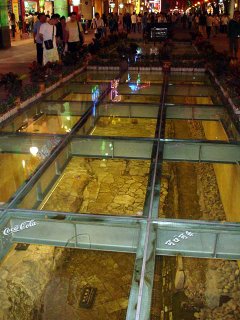 It was not only one street but actually layer upon layer of streets from various periods dating back to the Tang Dynasty (618 to 907 AD). Between then and the period of the Republic of China (1912 to 1949), ten additional layers were added. The bottom grit layer is about 3 meters below the surface. At a depth of 4.5 meters, the remains of the Southern Yue Kingdom (203 to 211 BC) were found. From 7.9 meters below, the surface lies gray-red virgin soil, which reveals that the site was once a riverbed. If you check out the photo, each label is from a different period of China's history. I hope we are able to find things like these in the Philippines.
It was not only one street but actually layer upon layer of streets from various periods dating back to the Tang Dynasty (618 to 907 AD). Between then and the period of the Republic of China (1912 to 1949), ten additional layers were added. The bottom grit layer is about 3 meters below the surface. At a depth of 4.5 meters, the remains of the Southern Yue Kingdom (203 to 211 BC) were found. From 7.9 meters below, the surface lies gray-red virgin soil, which reveals that the site was once a riverbed. If you check out the photo, each label is from a different period of China's history. I hope we are able to find things like these in the Philippines. After taking some photos, we went back to the hotel to eat our supermarket dinner. Didn't stay up too late since my flight was early in the morning and I had to be up before 6 a.m. to catch the 50-minute shuttle to the airport. My flight back to Manila leaves at 8:45 a.m. Anyway, this is my last post on my China trip. Until the next adventure!
After taking some photos, we went back to the hotel to eat our supermarket dinner. Didn't stay up too late since my flight was early in the morning and I had to be up before 6 a.m. to catch the 50-minute shuttle to the airport. My flight back to Manila leaves at 8:45 a.m. Anyway, this is my last post on my China trip. Until the next adventure!
 I arrived in Shanghai at 7 a.m. this morning. I was met at the station by the staff of the Philippine Consulate. Since I had to catch my flight in Guangzhou on November 7, and the train from Shanghai to Guangzhou was close to 24 hours, I only had one full day in Shanghai. I was staying for a night at the residence of the consul-general in Shanghai who is my brod, Ambassador Jess Yabes.
I arrived in Shanghai at 7 a.m. this morning. I was met at the station by the staff of the Philippine Consulate. Since I had to catch my flight in Guangzhou on November 7, and the train from Shanghai to Guangzhou was close to 24 hours, I only had one full day in Shanghai. I was staying for a night at the residence of the consul-general in Shanghai who is my brod, Ambassador Jess Yabes. We went around the city first since Jess was expecting us at 9 a.m. So they took me to the Bund (
We went around the city first since Jess was expecting us at 9 a.m. So they took me to the Bund (外灘
), one of the major attractions of Shanghai. The Bund is a living exhibition of buildings of various architectural styles which I wll discuss in detail later.From the promenade along the Bund, you could see Pudong on the opposite side of the Huangpu River and another famous landmark of Shanghai, the Oriental Pearl TV Tower (东方明珠塔
), the tallest tower in Asia and the third tallest in the world.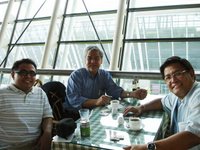 We then proceeded to the apartment where another brod, The World Tonight anchor Angelo Castro, Jr. was preparing to leave for the airport for his flight back to Manila. So after freshening up and getting settled, we proceeded to the Pudong International Airport to see Angelo off. Since there was a lot of time, we had coffee at one of the airport cafes. After Angelo left, Jess and I proceeded to The Portman Ritz-Carlton and had lunch at the Hanagatami Japanese Restaurant.
We then proceeded to the apartment where another brod, The World Tonight anchor Angelo Castro, Jr. was preparing to leave for the airport for his flight back to Manila. So after freshening up and getting settled, we proceeded to the Pudong International Airport to see Angelo off. Since there was a lot of time, we had coffee at one of the airport cafes. After Angelo left, Jess and I proceeded to The Portman Ritz-Carlton and had lunch at the Hanagatami Japanese Restaurant.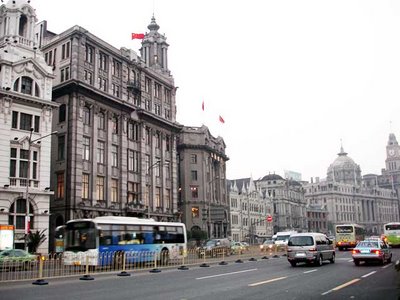 Since Jess wasn't feeling well, we went back to the apartment. I opted to rest for the afternoon too. I remember leaving the apartment at 4 p.m. to go back to the Bund. I wanted to check it out in the evening with the lighting and all.
Since Jess wasn't feeling well, we went back to the apartment. I opted to rest for the afternoon too. I remember leaving the apartment at 4 p.m. to go back to the Bund. I wanted to check it out in the evening with the lighting and all. The Bund is actually an area along the Huangpu River which served as the historical core of the city. Originally a British settlement, it was the heart of a building boom in the late 19th and early 20th centuries which made it a major financial hub of East Asia. It hosted among others banks and trading houses from the UK, France, USA, Russia, Germany, Japan, The Netherlands and Belgium, as well as the consulates of Russia and Britain, a newspaper, the Shanghai Club and the Masonic Club.Many of these buildings were preserved and today, the area houses 52 buildings of various architectural styles such as Romanesque, Gothic, Renaissance, Baroque, Neo-Classical, Beaux-Arts, and Art Deco. It is said that Shanghai has one of the richest collections of Art Deco architecture in the world.
The Bund is actually an area along the Huangpu River which served as the historical core of the city. Originally a British settlement, it was the heart of a building boom in the late 19th and early 20th centuries which made it a major financial hub of East Asia. It hosted among others banks and trading houses from the UK, France, USA, Russia, Germany, Japan, The Netherlands and Belgium, as well as the consulates of Russia and Britain, a newspaper, the Shanghai Club and the Masonic Club.Many of these buildings were preserved and today, the area houses 52 buildings of various architectural styles such as Romanesque, Gothic, Renaissance, Baroque, Neo-Classical, Beaux-Arts, and Art Deco. It is said that Shanghai has one of the richest collections of Art Deco architecture in the world.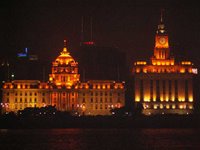 One thing I try to do when I visit a city is take a river tour since it really gives you a feel of the place. I've done it in Bangkok and Singapore, as well as Hong Kong. In developed countries, riverfront properties are very expensive.
One thing I try to do when I visit a city is take a river tour since it really gives you a feel of the place. I've done it in Bangkok and Singapore, as well as Hong Kong. In developed countries, riverfront properties are very expensive.
I hope they rehabilitate the banks of the Pasig River. There are still a lot of old structures in the Manila area, a sign of its rich history. While in the Makati and Pasig City areas, political will is needed to push for the relocation of factories elswhere so that the riverbanks could be redeveloped into open spaces and recreation areas for Metro Manila's citizens to breathe.
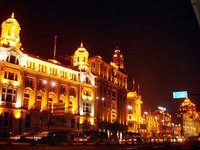 I purchased tickets for a river cruise along the Huangpu River. The day cruises are RMB45 while the night cruises are a little more expensive. But you could get the 6 to 7 p.m. cruise which is still considered a day tour, but at the same time enjoy the magnificently-lit skyline of Shanghai. Make sure you are at the ticket outlet at least 30 minutes before your tour since the port is a distance away and they have shuttle buses which transport passengers from the Bund to the port.
I purchased tickets for a river cruise along the Huangpu River. The day cruises are RMB45 while the night cruises are a little more expensive. But you could get the 6 to 7 p.m. cruise which is still considered a day tour, but at the same time enjoy the magnificently-lit skyline of Shanghai. Make sure you are at the ticket outlet at least 30 minutes before your tour since the port is a distance away and they have shuttle buses which transport passengers from the Bund to the port.
 The views of the Bund and Pudong from the Huangpu River were great! The cruise came with a narration in both Chinese and English, explaining the significance of the areas we passed. The only sad part was that I didn't bring my jacket since it was a little warmer in Shanghai than in Beijing. But it skipped my mind that temperatures dropped in the evening. So I guess you know what happened.
The views of the Bund and Pudong from the Huangpu River were great! The cruise came with a narration in both Chinese and English, explaining the significance of the areas we passed. The only sad part was that I didn't bring my jacket since it was a little warmer in Shanghai than in Beijing. But it skipped my mind that temperatures dropped in the evening. So I guess you know what happened.
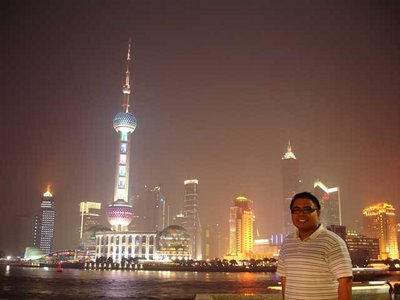 Anyway, I enjoyed the cruise. As soon as I got back to the Bund, I took photos of the Shanghai skyline as well as the buildings in the Bund.
Anyway, I enjoyed the cruise. As soon as I got back to the Bund, I took photos of the Shanghai skyline as well as the buildings in the Bund. I walked up to the Gutzlaff Signal Tower which was converted into a museum. One thing I noticed on the building was a granite marker which said "HERITAGE ARCHITECTURE." What made it more significant was the fact that it was installed by the Shanghai Municipal Government. How I wish the City of Manila would do that too instead of demolishing its heritage structures!Tomorrow I leave for Guangzhou by train at 11:26 a.m.
I walked up to the Gutzlaff Signal Tower which was converted into a museum. One thing I noticed on the building was a granite marker which said "HERITAGE ARCHITECTURE." What made it more significant was the fact that it was installed by the Shanghai Municipal Government. How I wish the City of Manila would do that too instead of demolishing its heritage structures!Tomorrow I leave for Guangzhou by train at 11:26 a.m.
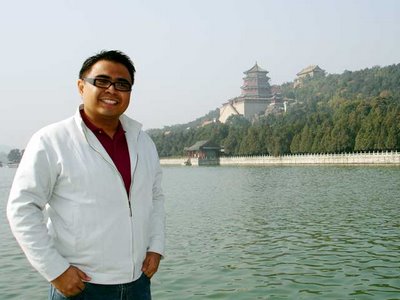 Today was our last day in Beijing. My two companions were leaving for Guangzhou at 1 p.m. So they had to prepare for the 22 hour train trip back. Marlon did some last minute shopping and was up really early. My train for Shanghai was leaving at 7 p.m. so I still had time for one more attraction. And today, I was scheduled to visit my fifth UNESCO World Heritage Site in Beijing, the Summer Palace.
Today was our last day in Beijing. My two companions were leaving for Guangzhou at 1 p.m. So they had to prepare for the 22 hour train trip back. Marlon did some last minute shopping and was up really early. My train for Shanghai was leaving at 7 p.m. so I still had time for one more attraction. And today, I was scheduled to visit my fifth UNESCO World Heritage Site in Beijing, the Summer Palace.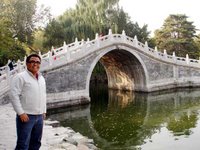 Known as Yiheyuan (頤和園), which literally means "Garden of Nurtured Harmony," the Summer Palace was first built in 1750 as the Qingyiyuan (清漪園) or Garden of Clear Ripples. However, it was ransacked in 1860 by British and French forces, together with the old Summer Palace, the Yuanmingyuan (圓明園). The Yuanmingyuan was totally destroyed but the Qingyiyuan survived.
Known as Yiheyuan (頤和園), which literally means "Garden of Nurtured Harmony," the Summer Palace was first built in 1750 as the Qingyiyuan (清漪園) or Garden of Clear Ripples. However, it was ransacked in 1860 by British and French forces, together with the old Summer Palace, the Yuanmingyuan (圓明園). The Yuanmingyuan was totally destroyed but the Qingyiyuan survived.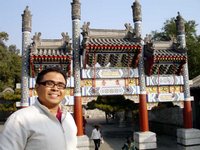 The current palace was rebuilt in 1886 by the Empress Dowager Cixi who diverted 30 million taels of silver meant for the Chinese navy to finance its construction. Cixi used it as her summer resort. It was christened Yiheyuan in 1888. In 1900, during the Boxer Rebellion, it was again damaged by an eight-nation allied invasion but survived. It was again reconstructed in 1902.
The current palace was rebuilt in 1886 by the Empress Dowager Cixi who diverted 30 million taels of silver meant for the Chinese navy to finance its construction. Cixi used it as her summer resort. It was christened Yiheyuan in 1888. In 1900, during the Boxer Rebellion, it was again damaged by an eight-nation allied invasion but survived. It was again reconstructed in 1902. Taking the cab was out of the question since the Summer Palace was quite a distance from the center of Beijing. I was told it was about 50 minutes by bus. For some reason, I was planning to leave at 8 a.m. but the next thing I knew, it was already 10 a.m. Hehe! Anyway, I was able to ask around which bus to take to the Yiheyuan and waitied at the bus stop. Just to be sure, I looked for the Chinese characters for Yiheyuan on the bus route posted at the stop and it turns out, the Summer Palace was the last stop of the bus. The cost of the bus was RMB5.
Taking the cab was out of the question since the Summer Palace was quite a distance from the center of Beijing. I was told it was about 50 minutes by bus. For some reason, I was planning to leave at 8 a.m. but the next thing I knew, it was already 10 a.m. Hehe! Anyway, I was able to ask around which bus to take to the Yiheyuan and waitied at the bus stop. Just to be sure, I looked for the Chinese characters for Yiheyuan on the bus route posted at the stop and it turns out, the Summer Palace was the last stop of the bus. The cost of the bus was RMB5. I finally arrived at the East Palace Gate of the Summer Palace after a long trip into the Beijing suburbs. I thought I could finish touring around in three hours but I under estimated its size since I found out that the complex covers an area of 290 hectares! So it was impossible to finish it before 3 p.m., the time I set for me to troop back to the city center to catch my train.The through ticket to the Summer Palace is RMB50. I also bought an English map of the place at RMB5 if I'm not mistaken. So I started my trek around the palace. There was no straight route to visit all the important structures since they were scattered around Kunming Lake and Longevity Hill.
I finally arrived at the East Palace Gate of the Summer Palace after a long trip into the Beijing suburbs. I thought I could finish touring around in three hours but I under estimated its size since I found out that the complex covers an area of 290 hectares! So it was impossible to finish it before 3 p.m., the time I set for me to troop back to the city center to catch my train.The through ticket to the Summer Palace is RMB50. I also bought an English map of the place at RMB5 if I'm not mistaken. So I started my trek around the palace. There was no straight route to visit all the important structures since they were scattered around Kunming Lake and Longevity Hill. As soon as I entered, a structure covered in scaffolding welcomed me. Yikes! I hoped this was the only one being restored. It turns out it was the only one since restoration on many of the Summer Palace buildings had already been completed. I first dropped by the Garden of Virtue and Harmony which was built as a theater for Cixi. Inside is the Grand Stage (left), a three-storey theater stage which is the largest and best-preserved wooden stage in China, and is considered the "Cradle of Beijing Opera." Behind it is a two-storey make-up room which is now a showroom of Cixi's carriages and automobile, believed to be the first car imported into China.
As soon as I entered, a structure covered in scaffolding welcomed me. Yikes! I hoped this was the only one being restored. It turns out it was the only one since restoration on many of the Summer Palace buildings had already been completed. I first dropped by the Garden of Virtue and Harmony which was built as a theater for Cixi. Inside is the Grand Stage (left), a three-storey theater stage which is the largest and best-preserved wooden stage in China, and is considered the "Cradle of Beijing Opera." Behind it is a two-storey make-up room which is now a showroom of Cixi's carriages and automobile, believed to be the first car imported into China. From there, I tried to walk towards the Seventeen-arch Bridge but it was quite far and I didn't have enough time. So I took a photo with Kunming Lake (昆明湖) and Longevity Hill (万寿山) as a background and then trekked towards the Tower of the Fragrance of the Buddha which was on top of the hill. Also bought some dumplings for a quick lunch. On the way to the hill, you would walk through the Long Corridor (长廊), which at 728 meters is reputedly the longest corridor in the world.
From there, I tried to walk towards the Seventeen-arch Bridge but it was quite far and I didn't have enough time. So I took a photo with Kunming Lake (昆明湖) and Longevity Hill (万寿山) as a background and then trekked towards the Tower of the Fragrance of the Buddha which was on top of the hill. Also bought some dumplings for a quick lunch. On the way to the hill, you would walk through the Long Corridor (长廊), which at 728 meters is reputedly the longest corridor in the world.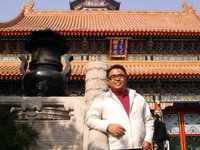 Welcoming you up the hill was the Hall that Dispels the Clouds or Paiyun Dian (left) which was built to celebrate Cixi's birthday. Inside were birthday gifts given to her by princes, dukes and high-ranking officials. I would have wanted to go up to the tower which housed a five-meter high gilded bronze statue of the Guanyin Bodhisattva cast in 1574; but time was against me. I still had a long walk and just an hour and a half left to go around. So I continued walking.
Welcoming you up the hill was the Hall that Dispels the Clouds or Paiyun Dian (left) which was built to celebrate Cixi's birthday. Inside were birthday gifts given to her by princes, dukes and high-ranking officials. I would have wanted to go up to the tower which housed a five-meter high gilded bronze statue of the Guanyin Bodhisattva cast in 1574; but time was against me. I still had a long walk and just an hour and a half left to go around. So I continued walking. Another attraction was the famous Marble Boat (石舫) also known as the Clear and Peaceful Boat. This 36-meter two-storey boat was carved out of a shadowy blue stone. It was a symbol of stability ofthe Qing Dynasty, an idea derived from the saying "Water can carry a boat, and it can also capsize a boat," serving as a warning to the emperor that he had to attend to state affairs with prudence.
Another attraction was the famous Marble Boat (石舫) also known as the Clear and Peaceful Boat. This 36-meter two-storey boat was carved out of a shadowy blue stone. It was a symbol of stability ofthe Qing Dynasty, an idea derived from the saying "Water can carry a boat, and it can also capsize a boat," serving as a warning to the emperor that he had to attend to state affairs with prudence. I was planning to exit via the North Palace Gate and it was still quite far. I passed by some trees which displayed autumn's colors but not as spledid as those we saw on the way to the Great Wall yesterday.
I was planning to exit via the North Palace Gate and it was still quite far. I passed by some trees which displayed autumn's colors but not as spledid as those we saw on the way to the Great Wall yesterday.
Also on the way were some nice bridges and more old structures until I finally reached the Hall of the Buddha Confirming His Docrine, a temple which housed gargantuan statues of the Buddha and various Buddhist saints.My last stop was Suzhou Street, a famous shopping street in the imperial gardens, imitating the shops along the canal in Suzhou. It was first built in 1751 and completely destroyed in 1860. The Chinese government totally rebuilt all the structures based on photos in 1991. The street is now an impressive assemblage of old shop houses. I hope they do this as well along the canals of Binondo since we have a lot of old photos of this charming area of Manila.
 I wasn't able to walk the entire area of Suzhou Street since it was already 3 p.m. and since it would take a while to get back to the city center, I decided to catch a bus. Outside was the stop for bus no. 808 which would take me to Tian'anmen Square. Again, the fare was RMB5. The trip was longer this time since traffic was heavy. The bus left at 3:30 p.m. and we were back in the city center at 5:15 p.m.
I wasn't able to walk the entire area of Suzhou Street since it was already 3 p.m. and since it would take a while to get back to the city center, I decided to catch a bus. Outside was the stop for bus no. 808 which would take me to Tian'anmen Square. Again, the fare was RMB5. The trip was longer this time since traffic was heavy. The bus left at 3:30 p.m. and we were back in the city center at 5:15 p.m.
 Since I didn't want to miss my train, I opted to take a cab back to the hotel to get my luggage and bring me straight to the train station. I arrived there at 6 p.m. which gave me just enough time to buy some dinner and then board the train to Shanghai. The trip was 12 hours and I was arriving in Shanghai at 7 a.m.
Since I didn't want to miss my train, I opted to take a cab back to the hotel to get my luggage and bring me straight to the train station. I arrived there at 6 p.m. which gave me just enough time to buy some dinner and then board the train to Shanghai. The trip was 12 hours and I was arriving in Shanghai at 7 a.m.
 What I thought was Beihai Park was actually Sichahai. I think I got my directions wrong so instead of going south towards Beihai, I walked north. As I entered, a group of rickshaw drivers started to pester me. They were showing me a map and saying that it was too far to walk. And that they would take me around the sites. I pretended not to be interested and from RMB180 which is the price in the map, they offered to take me around for an hour for RMB50.
What I thought was Beihai Park was actually Sichahai. I think I got my directions wrong so instead of going south towards Beihai, I walked north. As I entered, a group of rickshaw drivers started to pester me. They were showing me a map and saying that it was too far to walk. And that they would take me around the sites. I pretended not to be interested and from RMB180 which is the price in the map, they offered to take me around for an hour for RMB50.
 So we went around beginning in Houhai or the west bank. I did not realize it until I did some research that what I actually did was a tour of the Beijing hutongs, which are narrow maze-like lanes and alleys that were typical of Beijing communities in the olden days.
So we went around beginning in Houhai or the west bank. I did not realize it until I did some research that what I actually did was a tour of the Beijing hutongs, which are narrow maze-like lanes and alleys that were typical of Beijing communities in the olden days.
Sichahai is the lakes area north of Beihai Park. You can walk around the lakes and into some of the old hutong alleys. There are also a lot of restaurants and bars along the lakes, especially in the southern tip of Qianhai called Lotus Lane.
 The driver took me to an alley with a lot of shops. I wasn't the one who wanted to go shopping but I just hit the tourist shop area of Beijing where in my opinion, the best Chinese souvenirs could be purchased at affordable prices, if you know how to bargain. I got myself an English version of Quotations from Chairman Mao Zedong (毛主席语录) which is known in the West as The Little Red Book. It is second only to the Bible in volume with over 900 million copies printed.
The driver took me to an alley with a lot of shops. I wasn't the one who wanted to go shopping but I just hit the tourist shop area of Beijing where in my opinion, the best Chinese souvenirs could be purchased at affordable prices, if you know how to bargain. I got myself an English version of Quotations from Chairman Mao Zedong (毛主席语录) which is known in the West as The Little Red Book. It is second only to the Bible in volume with over 900 million copies printed.
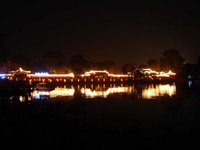 We went around more hutongs but since it was already getting dark, I wasn't able to appreciate it that much. The driver also brought me to some traditional houses which were converted into museums but I didn't want to spend for entrance which was about RMB40 each.
We went around more hutongs but since it was already getting dark, I wasn't able to appreciate it that much. The driver also brought me to some traditional houses which were converted into museums but I didn't want to spend for entrance which was about RMB40 each.
 When the tour ended, I took a walk again in Sichahai, this time along Lotus Lane which was flooded in lights (above right). The restaurants looked very appealing but again, I was on a very tight budget so I decided to have dinner elsewhere. I saw a structure from a distance and it turned out to be the Drum Tower or Gulou. So I walked towards it.
When the tour ended, I took a walk again in Sichahai, this time along Lotus Lane which was flooded in lights (above right). The restaurants looked very appealing but again, I was on a very tight budget so I decided to have dinner elsewhere. I saw a structure from a distance and it turned out to be the Drum Tower or Gulou. So I walked towards it.
Right beside the Drum Tower was the Bell Tower or Zhonglou (left). It was quite difficult to get a good shot of the Drum Tower in the evening since it was quite massive and there was no good angle to shoot from. But I got a photo of the Bell Tower. Hehe!
 I found myself on a shopping street and decided to keep walking southwards towards the hotel. Along the way, I found dinner! It was siopao! Haha! There were different kinds such as those stuffed with pork, and the rest were stuffed with various vegetables and tofu. I don't think we have vegetable-stuffed siopao in the Philippines. The clincher here was that each piece was just RMB0.80 or roughly PHP5 each! Now that was a cheap dinner. Haha!
I found myself on a shopping street and decided to keep walking southwards towards the hotel. Along the way, I found dinner! It was siopao! Haha! There were different kinds such as those stuffed with pork, and the rest were stuffed with various vegetables and tofu. I don't think we have vegetable-stuffed siopao in the Philippines. The clincher here was that each piece was just RMB0.80 or roughly PHP5 each! Now that was a cheap dinner. Haha!
Since I was already tired from walking, I decided to take a taxi back to the hotel. I was already prepared to sleep when Rhea and Marlon found out about Sichahai. So I agreed to go back with them to show them the place so they could shop for more souvenirs.
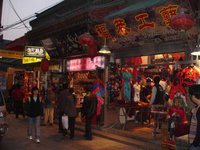 While we were checking out the shops, I saw a sign which said foot massage for just RMB38. And since my feet were aching, I could not resist. When we got back to the hotel, I went straight to bed.
While we were checking out the shops, I saw a sign which said foot massage for just RMB38. And since my feet were aching, I could not resist. When we got back to the hotel, I went straight to bed.
 We had to get up early today for our visit to the Great Wall of China (萬里長城). The day before, we booked seats with the travel agent in our hotel for a package tour to the Great Wall and Ming Tombs (明朝十三陵). The price was RMB150 which we felt was a good deal since it included transportation, entrance to the sites, and lunch.
We had to get up early today for our visit to the Great Wall of China (萬里長城). The day before, we booked seats with the travel agent in our hotel for a package tour to the Great Wall and Ming Tombs (明朝十三陵). The price was RMB150 which we felt was a good deal since it included transportation, entrance to the sites, and lunch.
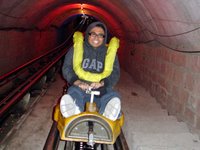 There were optional fees which included RMB60 for a slide car ride up the mountain and down back; as well as RMB40 for extra sites which we could not get the agency to explain in English. So we opted for the slide car ride. Another option up the mountain was a cable car ride but the tour they offered did not have that option since the drop off point for the cable car was in another part of the Great Wall.
There were optional fees which included RMB60 for a slide car ride up the mountain and down back; as well as RMB40 for extra sites which we could not get the agency to explain in English. So we opted for the slide car ride. Another option up the mountain was a cable car ride but the tour they offered did not have that option since the drop off point for the cable car was in another part of the Great Wall.
 Anyway, the bus passed by for us in the hotel at 7:15 a.m. and there were already other passengers. The sad thing was the guide was speaking in Chinese since it turns out, we were the only foreigners on the bus.
Anyway, the bus passed by for us in the hotel at 7:15 a.m. and there were already other passengers. The sad thing was the guide was speaking in Chinese since it turns out, we were the only foreigners on the bus.
On the way, one of the passengers started a shouting match with the guide. We had figured that it had something to do with the payment since the guides were doing rounds of the passengers collecting money. It turns out, the optional fees were not optional and they were collecting the said fees from those who did not pay. So that’s why one of the passengers got hysterical since she thought it was optional and didn’t want to pay for it. So we too had to pay the RMB40 which we opted not to take. Oh well!
 The northern pass of Juyongguan Pass is known as Badaling. This particular area of the Great Wall is the most visited by tourists. This portion of the Great Wall is 7.8 meters high and 5 meters wide.
The northern pass of Juyongguan Pass is known as Badaling. This particular area of the Great Wall is the most visited by tourists. This portion of the Great Wall is 7.8 meters high and 5 meters wide.
As we neared Badaling, the view outside of the tall mountains and traces of the Great Wall was just awe-inspiring. When we exited the bus at the drop off point, a gush of frigid wind hit us. We completely forgot that it was much colder here than the city proper since we were high up in the mountains. It was so cold that I had to put on my hood to keep my ears warm. I should have purchased gloves the day before since the stalls were selling them at exorbitantly high prices. So I had to make do with the pouch in my sweater to keep my hands warm.
 The Great Wall of China (萬里長城) was built to protect the various dynasties from raids by Hunnic, Mongol, Turkic, and other nomadic tribes coming from areas in modern-day Mongolia and Manchuria. Although several walls were built since the 3rd century BC, the most famous being built between 220 BC and 200 BC by the first emperor of China, Qin Shi Huang, little of those earlier walls remain. It is the world's longest man-made structure, stretching over 6,352 kilometers. Mao Zedong had a saying: 不到長城非好漢, "You're not a hero if you haven't climbed the Great Wall."
The Great Wall of China (萬里長城) was built to protect the various dynasties from raids by Hunnic, Mongol, Turkic, and other nomadic tribes coming from areas in modern-day Mongolia and Manchuria. Although several walls were built since the 3rd century BC, the most famous being built between 220 BC and 200 BC by the first emperor of China, Qin Shi Huang, little of those earlier walls remain. It is the world's longest man-made structure, stretching over 6,352 kilometers. Mao Zedong had a saying: 不到長城非好漢, "You're not a hero if you haven't climbed the Great Wall."
 We boarded the slide cars up the mountain which brought us straight to the entrance of the Great Wall. This was the third UNESCO World Heritage Site I visited in just two days. I guess my high spirits just overtook me as I walked the wall and I didn’t realize I had walked a long distance already. The wall stretched as far as the eye could see. The experience was just surreal.
We boarded the slide cars up the mountain which brought us straight to the entrance of the Great Wall. This was the third UNESCO World Heritage Site I visited in just two days. I guess my high spirits just overtook me as I walked the wall and I didn’t realize I had walked a long distance already. The wall stretched as far as the eye could see. The experience was just surreal.
 The guides gave us an hour and a half to do our thing. Then we were off to the next destination. I thought our next stop was lunch but we were herded into a jewelry shop, and after that, a sort of food supermarket which sold vacuum-packed Peking duck, dried fruits, pastries and breads and the like. Lunch was beside the supermarket which I was not satisfied with since it was mostly rice and vegetables. So I ended up buying corn and a grilled sausage from the vendors outside.
The guides gave us an hour and a half to do our thing. Then we were off to the next destination. I thought our next stop was lunch but we were herded into a jewelry shop, and after that, a sort of food supermarket which sold vacuum-packed Peking duck, dried fruits, pastries and breads and the like. Lunch was beside the supermarket which I was not satisfied with since it was mostly rice and vegetables. So I ended up buying corn and a grilled sausage from the vendors outside.
I would later read in Wikitravel a warning about tours being touted in the Forbidden City area with prices between RMB100 to 150 since these tours earned from commissions from all these outlets they bring their passengers to. Although ours was legitimate since it came from our hotel travel agency, I figured our tour was cheap since they earned if any of the passengers bought from the shops they brought us to.
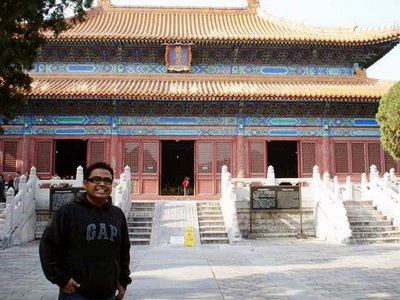 After lunch, we went to one of the Ming Tombs (明朝十三陵). There are thirteen imperial tombs of the Ming Dynasty scattered in an area of about 40 square kilometers in the Changping District of Beijing. They were inscribed in the UNESCO World Heritage List in 2003.
After lunch, we went to one of the Ming Tombs (明朝十三陵). There are thirteen imperial tombs of the Ming Dynasty scattered in an area of about 40 square kilometers in the Changping District of Beijing. They were inscribed in the UNESCO World Heritage List in 2003.
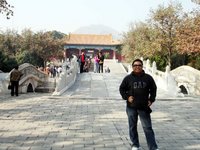 It was the Yongle Emperor, the third Ming emperor, who chose the site of the Ming Tombs. Ruling from 1402 to 1424, he was responsible for moving the capital from Nanjing to Beijing and is credited with envisioning the layout of the ancient city of Beijing. After the construction of the Forbidden City in 1420, Yongle selected his burial site and created his own mausoleum. All in all, 13 out of 16 Ming Dynasty emperors were buried in the area. The tombs of the first two Ming Emperors are located near Nanjing, the capital city during their reigns.
It was the Yongle Emperor, the third Ming emperor, who chose the site of the Ming Tombs. Ruling from 1402 to 1424, he was responsible for moving the capital from Nanjing to Beijing and is credited with envisioning the layout of the ancient city of Beijing. After the construction of the Forbidden City in 1420, Yongle selected his burial site and created his own mausoleum. All in all, 13 out of 16 Ming Dynasty emperors were buried in the area. The tombs of the first two Ming Emperors are located near Nanjing, the capital city during their reigns.
 Only three tombs are open to the public namely Changling, Dingling and Zhaoling. Of these, only the tumulus (underground chamber) of the Dingling Tomb has been opened. Chinese archaeologists are excited about opening the Changling tumulus housing the powerful Yongle Emperor and possibly containing the remaining copy of the Great Dictionary of Yongle (Yongle Dadian).
Only three tombs are open to the public namely Changling, Dingling and Zhaoling. Of these, only the tumulus (underground chamber) of the Dingling Tomb has been opened. Chinese archaeologists are excited about opening the Changling tumulus housing the powerful Yongle Emperor and possibly containing the remaining copy of the Great Dictionary of Yongle (Yongle Dadian).
We visited the Zhaoling Tomb (昭陵)
of Zhu Zaihou (朱載垕), also known as Emperor Muzong (穆宗) or the Longqing Emperor (隆慶) and his three empresses. His reign lasted only six years from1566 to 1572. It wasn't the best of the Ming Tombs though and I felt our guides were just being wise since it had the cheapest entrance fee at RMB30. As they say, "If you've seen one, you've seen them all." Hehe!
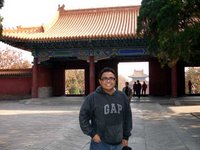 Anyway, after a brief tour of the tomb, we were back to the bus. I was expecting that the extra site was another Ming Tomb but instead they brought us to a wax museum about the Ming Dynasty. Since I’ve seen so many museums before, I would have wanted to stay in the bus and save my money but the guide refused since I think they paid a group rate. So obviously, they were also able to earn from that.
Anyway, after a brief tour of the tomb, we were back to the bus. I was expecting that the extra site was another Ming Tomb but instead they brought us to a wax museum about the Ming Dynasty. Since I’ve seen so many museums before, I would have wanted to stay in the bus and save my money but the guide refused since I think they paid a group rate. So obviously, they were also able to earn from that.
But the museum was not bad since the life-size dioramas were really great and thanks to the English translations of the various scenes, I was able to learn a lot. It was just that I would have wanted to spend the RMB40 on another Ming Tomb.
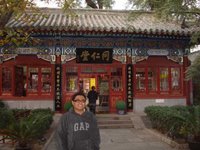 With that done, the group went back to central Beijing. I thought the tour was over but they brought us to one last stop. We went to a traditional Chinese drugstore next which was called the Beijing Tongrentang. I felt it was consistent with the Wikitravel warning. Hehe! They were giving a lecture but it was in Chinese so we were able to excuse ourselves from the sales talk which I felt they were doing in there. But the building had a lot of history since it provided medicine for royalty since 1723. It even had the golden dragon on its ceiling, a sign that it served the emperor.
With that done, the group went back to central Beijing. I thought the tour was over but they brought us to one last stop. We went to a traditional Chinese drugstore next which was called the Beijing Tongrentang. I felt it was consistent with the Wikitravel warning. Hehe! They were giving a lecture but it was in Chinese so we were able to excuse ourselves from the sales talk which I felt they were doing in there. But the building had a lot of history since it provided medicine for royalty since 1723. It even had the golden dragon on its ceiling, a sign that it served the emperor.
On the way to the Tongrentang, we saw a tourist information office right beside what looked like Beihai Park. So we told the guides that we would stay behind. From there, we walked towards the office and asked some questions. Got myself a better map of Beijing. Rhea and Marlon wanted to go shopping since it was their last chance. While I wanted to check out the park. So from there, we parted ways and did our own thing.
 I arrived at the Guangzhou East Train Station at 11 a.m. I was met at the station by Jiajin, our liaison officer during the program who was nice enough to take me around Guangzhou during my last day in China. We hadn't been able to see Guangzhou during the program in Guangdong Province since the activities were in Dongguan City.
I arrived at the Guangzhou East Train Station at 11 a.m. I was met at the station by Jiajin, our liaison officer during the program who was nice enough to take me around Guangzhou during my last day in China. We hadn't been able to see Guangzhou during the program in Guangdong Province since the activities were in Dongguan City. Since Jiajin had classes at 3 p.m., we took a 40-minute bus to the Guandong University of Foreign Studies where he is a graduating student. I stayed at his dorm and surfed the Internet while he was in class.
Since Jiajin had classes at 3 p.m., we took a 40-minute bus to the Guandong University of Foreign Studies where he is a graduating student. I stayed at his dorm and surfed the Internet while he was in class. It was not only one street but actually layer upon layer of streets from various periods dating back to the Tang Dynasty (618 to 907 AD). Between then and the period of the Republic of China (1912 to 1949), ten additional layers were added. The bottom grit layer is about 3 meters below the surface. At a depth of 4.5 meters, the remains of the Southern Yue Kingdom (203 to 211 BC) were found. From 7.9 meters below, the surface lies gray-red virgin soil, which reveals that the site was once a riverbed. If you check out the photo, each label is from a different period of China's history. I hope we are able to find things like these in the Philippines.
It was not only one street but actually layer upon layer of streets from various periods dating back to the Tang Dynasty (618 to 907 AD). Between then and the period of the Republic of China (1912 to 1949), ten additional layers were added. The bottom grit layer is about 3 meters below the surface. At a depth of 4.5 meters, the remains of the Southern Yue Kingdom (203 to 211 BC) were found. From 7.9 meters below, the surface lies gray-red virgin soil, which reveals that the site was once a riverbed. If you check out the photo, each label is from a different period of China's history. I hope we are able to find things like these in the Philippines. After taking some photos, we went back to the hotel to eat our supermarket dinner. Didn't stay up too late since my flight was early in the morning and I had to be up before 6 a.m. to catch the 50-minute shuttle to the airport. My flight back to Manila leaves at 8:45 a.m. Anyway, this is my last post on my China trip. Until the next adventure!
After taking some photos, we went back to the hotel to eat our supermarket dinner. Didn't stay up too late since my flight was early in the morning and I had to be up before 6 a.m. to catch the 50-minute shuttle to the airport. My flight back to Manila leaves at 8:45 a.m. Anyway, this is my last post on my China trip. Until the next adventure!









































